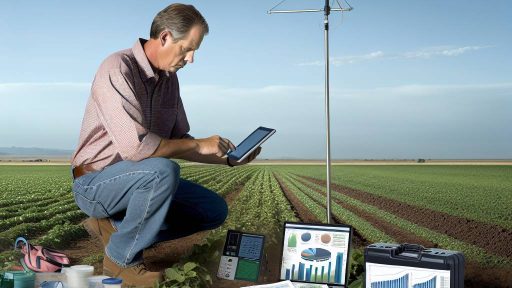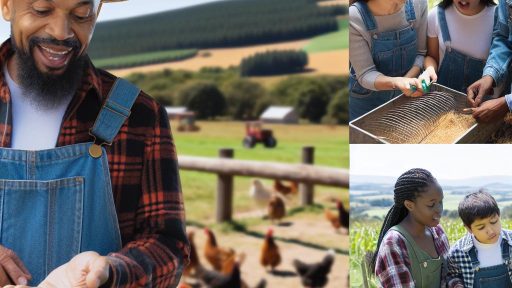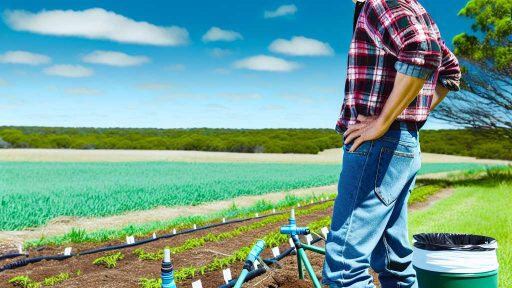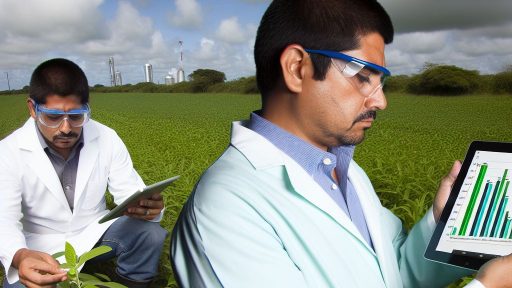Overview of Precision Agriculture
Definition
Precision agriculture refers to the use of technology to monitor and manage farm resources.
This approach focuses on efficiently using inputs like seeds, water, and fertilizers.
Farmers utilize data analytics to enhance crop yields and reduce waste.
Importance
Precision agriculture plays a crucial role in modern farming practices.
It maximizes yield while minimizing environmental impact.
Farmers can tailor their practices to specific field variability.
This enhances resource efficiency and reduces costs.
Moreover, it contributes to sustainable agricultural practices.
Key Benefits
- Improved crop management through precise data collection.
- Enhanced operational efficiency by optimizing resource use.
- Increased profitability for farmers through cost reductions.
Tools and Technologies
Farmers employ various tools in precision agriculture.
GPS technology aids in accurate field mapping.
Drones provide aerial insights into crop health and soil conditions.
Soil sensors offer real-time data on moisture and nutrient levels.
Future Perspectives
The future of precision agriculture looks promising.
Advancements in AI and machine learning will enhance decision-making.
Integration with Internet of Things (IoT) will improve connectivity.
Transform Your Agribusiness
Unlock your farm's potential with expert advice tailored to your needs. Get actionable steps that drive real results.
Get StartedThese technologies will drive further efficiencies in farming operations.
Key Technologies in Precision Agriculture
Introduction to Precision Agriculture
Precision agriculture utilizes technology to enhance farming practices.
This approach allows farmers to make data-driven decisions.
Ultimately, it improves crop yields and reduces waste.
Global Positioning System (GPS)
GPS technology enables accurate field mapping.
Farmers use it to guide machinery with precision.
This tool helps in variable rate applications for fertilizers and seeds.
Therefore, GPS minimizes overlaps and reduces input costs.
Geographic Information Systems (GIS)
GIS is crucial for analyzing spatial data.
It assists in understanding soil variability across fields.
Farmers can develop comprehensive management plans using GIS.
This technology enhances decision-making based on geographic data.
Remote Sensing
Remote sensing involves collecting data from a distance.
This method uses drones and satellites for field monitoring.
Farmers can assess crop health and identify issues early.
Consequently, timely interventions can be made to boost yields.
Soil Sensors
Soil sensors measure moisture levels and nutrient content.
They provide real-time data to optimize irrigation.
Farmers can apply fertilizers more effectively using this information.
Thus, soil sensors contribute to sustainable farming practices.
Yield Monitors
Yield monitors collect data on crop performance during harvest.
Farmers analyze this data to understand productivity patterns.
It helps in identifying high and low-yield areas in fields.
As a result, farmers can refine their strategies for future seasons.
Showcase Your Farming Business
Publish your professional farming services profile on our blog for a one-time fee of $200 and reach a dedicated audience of farmers and agribusiness owners.
Publish Your ProfileVariable Rate Technology (VRT)
VRT allows for the application of inputs at variable rates.
Farmers can tailor applications to specific field areas.
Consequently, this approach optimizes resource use and reduces costs.
Additionally, it helps in minimizing environmental impacts.
Data Management Software
Data management software collects and analyzes agricultural data.
This software aids farmers in making informed decisions.
Moreover, it helps track input costs and profitability.
As a result, farm management is more efficient and strategic.
Future Directions in Precision Agriculture
Integrating these technologies enhances farm productivity.
Precision agriculture represents the future of farming.
Farmers can expect improved efficiency and sustainability.
Benefits of Precision Agriculture Tools for Farm Productivity
Improved Resource Management
Precision agriculture tools optimize resource use on farms.
These tools help farmers apply inputs like water and fertilizers efficiently.
As a result, they reduce waste and save costs.
Farmers can also track resources in real time.
This leads to more informed decision-making.
Increased Crop Yields
Using precision agriculture enhances crop yields significantly.
Farmers receive accurate data on soil health and moisture levels.
This data helps identify the best planting and harvesting times.
Ultimately, it leads to healthier plants and higher production.
Enhanced Pest and Disease Management
Precision tools aid in the early detection of pest infestations.
Farmers can use this information to implement targeted interventions.
By addressing issues promptly, they minimize crop damage.
Furthermore, these tools help in monitoring environmental conditions.
Consequently, farmers can predict disease outbreaks more effectively.
Cost Efficiency
Investing in precision agriculture tools often results in long-term savings.
Farmers can reduce expenditure on inputs due to optimized usage.
Additionally, lower labor costs contribute to overall efficiency.
In many cases, higher yields offset the initial investment costs.
Environmental Sustainability
Precision agriculture promotes sustainable farming practices.
By minimizing chemical runoff, it protects local water sources.
Moreover, it encourages practices that enhance soil health.
This approach supports biodiversity and reduces the carbon footprint.
Overall, it ensures farming is more eco-friendly.
You Might Also Like: Enhancing Visitor Experience With Unique Agritourism Activities
Case Studies: Successful Implementation of Precision Agriculture
Improving Yields with Data-Driven Approaches
Farmers often use precision agriculture to increase crop yields effectively.
For instance, Green Valley Farms incorporated soil sensors and data analytics.
These tools provided insights on soil moisture and nutrient levels.
As a result, the farm reported a 15% increase in corn production.
Furthermore, the use of targeted irrigation reduced water consumption significantly.
Showcase Your Farming Business
Publish your professional farming services profile on our blog for a one-time fee of $200 and reach a dedicated audience of farmers and agribusiness owners.
Publish Your ProfileReducing Costs Through Precision Techniques
Another striking example is Maple Hill Orchards.
This company adopted drone technology for crop monitoring.
The drones identified areas requiring pest control more efficiently.
Consequently, they reduced pesticide use by 20%.
This practice not only saved money but also protected beneficial insects.
Enhancing Sustainability with Smart Farming
Highland Family Farms focused on sustainable methods using precision farming.
They implemented crop rotation and cover crops based on satellite data.
This approach improved soil health and reduced erosion considerably.
Thanks to these adjustments, the farm saw an increase in biodiversity.
In turn, this led to improved resilience against pests and diseases.
Case Study: Market Integration and Consumer Awareness
Sunny Acres Initiative developed a direct-to-consumer sales platform.
This platform provided consumers with information about their food sources.
By leveraging precision agriculture data, Sunny Acres increased transparency.
Customers appreciated knowing how their food was grown sustainably.
As a result, the initiative boosted customer trust and loyalty significantly.
Future Trends in Precision Agriculture
The success stories showcase the potential of precision agriculture tools.
Emerging technologies continue to shape farming practices worldwide.
Farmers must stay informed about innovations in data analysis and automation.
Ultimately, these advancements will help enhance productivity and sustainability.
Consequently, the agricultural landscape is set to evolve rapidly.
Find Out More: Effective Budgeting Strategies For Comprehensive Farm Financial Management
Sensors and Data Collection Methods in Precision Agriculture
Introduction to Precision Agriculture Technologies
Precision agriculture utilizes advanced technologies to enhance farming practices.
These technologies allow farmers to monitor and manage field variability efficiently.
Through data collection, farmers can improve decision-making processes.
Types of Sensors Used in Agriculture
Sensors play a crucial role in precision agriculture.
They collect data on soil, air, and plant conditions.
Common sensor types include moisture sensors, temperature sensors, and nutrient sensors.
- Moisture sensors measure soil moisture levels.
- Temperature sensors track air and soil temperatures.
- Nutrient sensors detect soil nutrient levels.
Data Collection Techniques
Farmers use various methods to gather data effectively.
These methods include ground-based sensors and aerial imagery.
Ground-based sensors provide real-time information from the field.
Aerial imagery captures a larger area and offers detailed crop insights.
The Role of Drones in Data Collection
Drones have revolutionized data collection in agriculture.
They enable farmers to survey vast areas quickly and efficiently.
Moreover, drones capture high-resolution images of crops.
This data helps farmers identify areas needing attention.
Remote Sensing Technology
Remote sensing technology enhances the ability to monitor crops from a distance.
It helps in assessing crop health and predicting yields.
This technology uses satellites and drones for imagery analysis.
Farmers gain valuable insights from the data provided.
Data Management Systems
Data management systems organize and analyze collected data.
Showcase Your Farming Business
Publish your professional farming services profile on our blog for a one-time fee of $200 and reach a dedicated audience of farmers and agribusiness owners.
Publish Your ProfileThese systems help farmers make informed decisions.
Farmers can track historical trends and predict future outcomes.
In addition, they support the integration of various data sources.
Learn More: Marketing Strategies For Successful Agritourism Businesses
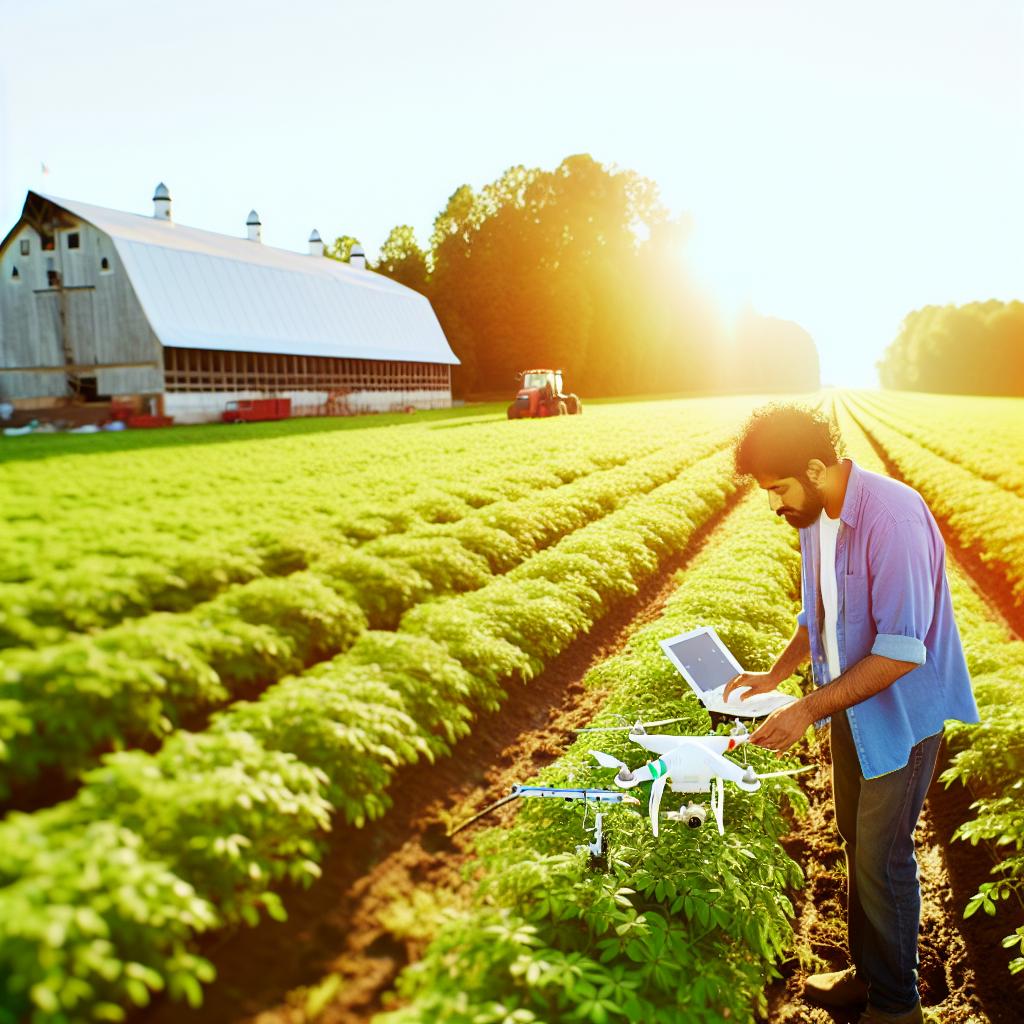
The Role of Drones and Aerial Imaging in Modern Farming
Enhancing Crop Monitoring
Drones revolutionize crop monitoring across vast agricultural lands.
Farmers can capture high-resolution images that reveal plant health.
These images help in identifying areas needing attention.
Consequently, farmers optimize resource usage effectively.
Improving Precision in Agriculture
Aerial imaging plays a crucial role in precision agriculture.
Drones provide precise data for targeted interventions.
Farmers can apply fertilizers and pesticides more efficiently.
This precision lessens waste and reduces costs.
Facilitating Soil Analysis
Drones assist in soil health assessments as well.
They gather data on moisture levels and nutrient content.
Farmers can analyze this data to improve soil management.
As a result, they enhance crop yield potential significantly.
Streamlining Crop Spraying
Modern drones enable effective and timely crop spraying.
These tools distribute fertilizers and pesticides with accuracy.
Drones cover large areas quickly, increasing efficiency.
This method reduces the amount of chemicals released into the environment.
Assessing Harvest Readiness
Aerial imaging aids in determining harvest readiness.
Drones can assess crop maturity and predict yields accurately.
This data allows farmers to plan timely harvests.
Ultimately, it maximizes market potential and profitability.
Learn More: Precision Agriculture Tools To Reduce Operational Costs
Integrating GPS Technology for Efficient Farm Management
Understanding GPS Technology
GPS technology plays a crucial role in modern agriculture.
Farmers can leverage GPS to increase accuracy in field operations.
This technology aids in precise planting, fertilizing, and harvesting.
Benefits of GPS Integration
Integrating GPS significantly boosts operational efficiency.
This technology minimizes overlaps during planting and spraying.
As a result, farmers save both time and resources.
Furthermore, it enhances crop yield by ensuring optimal planting strategies.
Improved Field Mapping
GPS allows for superior mapping of farms and fields.
Farmers can assess soil types and moisture levels accurately.
This data supports informed decision-making for crop management.
Additionally, it allows better resource allocation in farming activities.
Real-Time Monitoring
Farmers can monitor field conditions in real time using GPS.
This capability leads to quicker reaction times to environmental changes.
Moreover, farmers can assess equipment performance and field productivity.
Investing in GPS Tools
Investing in GPS technology can yield high returns for farmers.
Showcase Your Farming Business
Publish your professional farming services profile on our blog for a one-time fee of $200 and reach a dedicated audience of farmers and agribusiness owners.
Publish Your ProfileMany companies offer affordable GPS solutions tailored to agriculture.
Advanced systems include automated guidance for machinery.
Such features enhance productivity and reduce operational costs.
Training and Support
Proper training is essential for utilizing GPS tools effectively.
Companies provide training sessions for farmers and farm staff.
Support services ensure users can troubleshoot and maximize their systems.
Success Stories
Numerous farmers report significant improvements post-GPS integration.
Case studies highlight increased yields and reduced waste.
Innovative farmers lead the way in adopting these technologies.
Future Trends in Precision Agriculture: Innovations on the Horizon
Technological Advancements
New technologies will reshape precision agriculture in the coming years.
Farmers will increasingly use drones for crop monitoring and analysis.
These aerial devices will provide high-resolution images and data.
Additionally, robots will streamline planting and harvesting processes.
Such innovations will significantly reduce labor costs and time.
Besides, artificial intelligence will enhance data analysis for farmers.
AI algorithms will enable better decision-making based on real-time data.
Increased Data Utilization
The future of farming hinges on data-driven insights.
Farmers will adopt more advanced sensors to gather field data.
Data from soil moisture sensors will inform irrigation practices.
Furthermore, yield monitors will guide planting strategies.
This will lead to more efficient resource allocation.
As a result, farmers will maximize yields while minimizing waste.
Integration of Sustainable Practices
Sustainability will play a pivotal role in future agriculture trends.
Farmers will adopt practices that support environmental health.
Precision agriculture will help reduce chemical inputs and runoff.
Technologies will enable more environmentally friendly farming techniques.
For instance, cover cropping can enhance soil health.
Farmers will increasingly monitor biodiversity on their farms.
Adoption of Cloud Technologies
Cloud computing will revolutionize how farmers manage data.
Access to cloud-based platforms will facilitate collaboration.
Farmers will share insights and strategies more effectively.
Moreover, real-time data analysis will become more accessible.
This will foster community-based solutions to agricultural challenges.
Focus on Precision Livestock Farming
Livestock management will also see precision agriculture innovations.
Sensors will help monitor animal health and productivity.
This will ensure early detection of diseases among livestock.
Farmers will retrieve actionable insights from wearable technology.
Such changes will enhance animal welfare and productivity.
Growing Role of Remote Sensing
Remote sensing technology will expand its role in agriculture.
Satellite imagery will provide critical information for farmers.
Showcase Your Farming Business
Publish your professional farming services profile on our blog for a one-time fee of $200 and reach a dedicated audience of farmers and agribusiness owners.
Publish Your ProfileThis technology will assist in crop health assessments.
Farmers will use this data for accurate yield predictions.
Consequently, planning will become more precise and informed.

